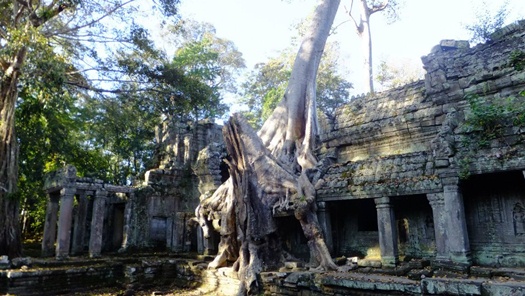I traveled to Southeast Asia mainly to visit the Angkor temples in Cambodia. They had been haunting my dreams for the better part of 2011 and had topped my ever-expanding travel list. No other destination would do for my first solo trip.
Traditionally, the history of Angkor begins in the 9th century, when the young king Jayavarman II declared himself the supreme sovereign and established it as his capital. The best-preserved and most well-known of the temples, Angkor Wat, was built in the early 12th century. It is the world’s largest religious monument, a UNESCO World Heritage Site, and an architectural masterpiece, rich in detail. It is the epitome of classic Khmer construction, giving full expression to religious symbolism: the moat surrounding Angkor Wat represents the mythical oceans surrounding the earth, the succession of concentric galleries represent the mountain ranges that surround Mount Meru, the home of the gods, while the towers represent the mountain’s peaks.
While Angkor Wat is beyond impressive, there are approximately one thousand temples at Angkor.
It definitely takes a few days to explore the site, but to avoid what I called “temple exhaustion” it’s best to read up a little about the site before visiting, and selecting which temples you’d like to see the most. I was fortunate enough to meet John McDermott, a photographer who has lived in Cambodia for a couple of decades and photographed Angkor extensively. Having great knowledge of the site, he recommended a special 2-day itinerary for me. I’m glad I followed his advice, and as such, would like to share it with anyone planning on visiting Angkor.
Note: While some may get temple exhaustion, 2 days was definitely not enough to enjoy the massive site, so if you have the time you should pace yourself and enjoy it.
DAY 1
I left my hotel at 5am to catch the sunrise over Angkor Wat. You should plan to arrive there by 5:30am; however, be warned, A LOT of people want that sunrise photo, so you will have to fight your way to a good spot. If you have a few days, I’d recommend going once to just enjoy the sunrise, and going another time if you really want to get that photo.
After getting your shot, by 6:30 or 7am, you’re ready to explore the temple. Take your time going through the many hallways, paying attention to the intricate details, as it has over 600m of narrative bas-reliefs and nearly 2,000 apsaras.
By 8:30 to 9:00am you should head to Bayon, before all the tours arrive and crowd the temple. It’s definitely one of the prettier temples. Bayon uniquely uses a mass of face-towers to create a stone mountain of ascending peaks.
Following Bayon, head to Preah Khan. It is similar to Ta Prohm (where a famous Tomb Raider scene was shot) but on a larger scale. Preah Khan was built on the site of a major battle in the recapture of Angkor from the Chams. You’ll see similar sights as you would in Ta Prohm, with the trees “eating” the temple.
Tip: Instead of doing the traditional North Gate to South Gate tour, go to East Gate first and walk to West Gate. You’ll need at least 2 hours here. I personally got lost in the jungle at Preah Khan, so I’d recommend you take a map. But definitely give this temple some time, it’s really beautiful and I regret not seeing too much of it after getting lost. I did manage to stumble upon a wedding ceremony being held at the temple. Definitely a unique place to get married!
Check out more information and tips after lunch on Day 1 and what happens on Day 2!
This story was brought to you by the lovely Reine Gammoh or @ReineOG on Twitter.
Guest Writer
I traveled to Southeast Asia – to Thailand & Cambodia – for my first ever solo trip. I got to experience many firsts; from my first time riding a tuk tuk and visiting a Buddhist temple, to scuba diving in the Gulf of Thailand and trying amazing street food. I have caught a bad case of the travel bug and can’t wait to see more of the world.







Leave a Reply